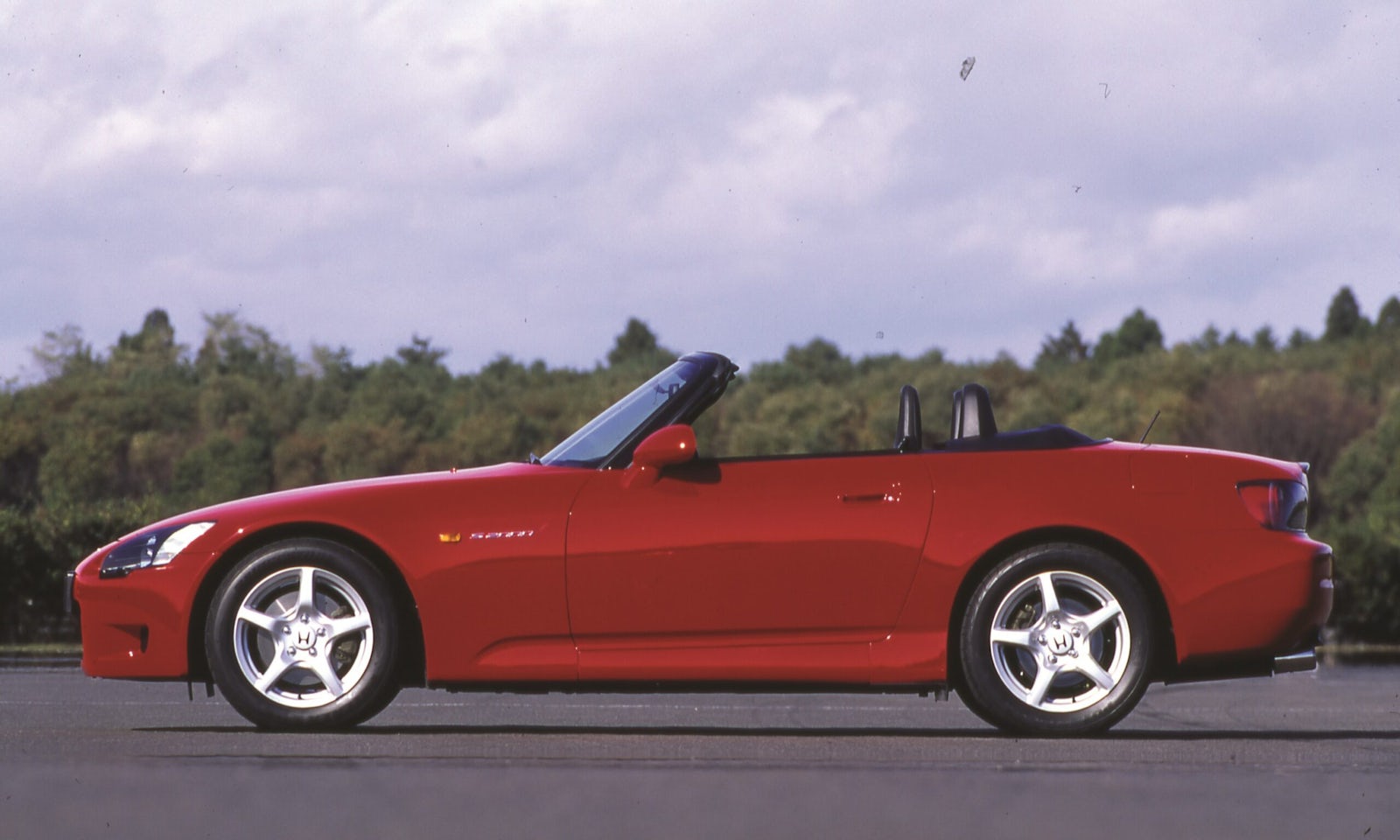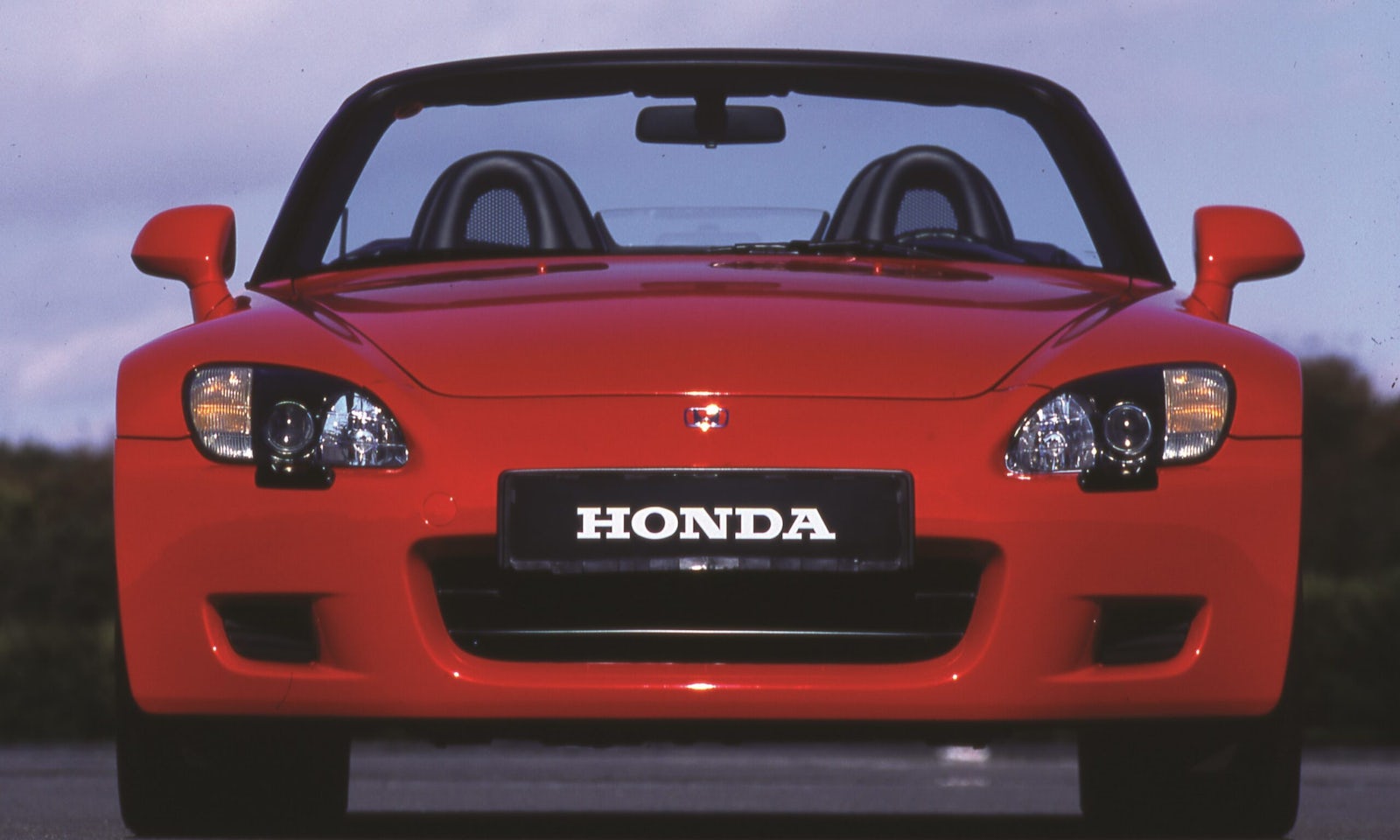Honda S2000 Review & Buyers Guide (1999-2009)
May 09, 2025 by Neil Briscoe

Adored by driving enthusiasts and boy racers alike, the Honda S2000 is one of the most desirable sports cars to ever come out of Japan. It’s a prime example of a modern classic in the making, so here’s what to look out for when on the hunt:
- The S2000 was Honda’s 50th birthday present to itself
- 110,000 were made across a 10-year production life
- The S2000 is 4.1 metres long, 1.7 metres wide, and weighs 1,274kg
- Power comes from a 2.0-litre (later 2.2-litre in some markets), four-cylinder engine with variable valve timing developing between 242-252hp
If you’re lucky, when you turn 50, you might get a nice present. A fancy watch, maybe? A trip to the Seychelles? Or maybe a new iPad. Honda, as is so often the case, decided to do things a little differently and, for its 50th anniversary of making cars, gave itself a present. A compact, light, two-seat sports car with a high-revving four-cylinder engine and quickfire chassis responses. Honda’s 50th pressie was shared with all of us as the S2000.
Now, it’s tempting to think of the S2000 — a Japanese-built two-seat sports car — as an alternative to the Mazda MX-5, but it’s not. The S2000 is a far more performance-focused machine than that, and its closest rival was really the Porsche Boxster.

Indeed, that 2.0-litre engine — later upgraded to 2.2 litres for the US and Japan — had one of the highest ‘specific outputs’ of the time. That refers to the amount of power produced for the engine’s cubic capacity. At 124hp per litre when it was launched, the S2000’s engine was closer to being a race-car unit than a humble road-going engine. Plus, it revved to 9,000rpm (only motorbikes and Formula One engines revved higher than that) and powered the rear wheels through one of the finest six-speed manual gearboxes ever made.
The S2000 may not have sold like a Civic, but Honda kept it in production for a full decade, and more than 100,000 were eventually made. The combo of sharp (slightly too sharp, as we’ll see) handling, that screaming engine, and Honda quality make the S2000 a proper burgeoning modern classic, but beware the ones that have fallen into the hands of the ‘Max Power’ brigade – dodgy modifications are never far away.

Is the Honda S2000 a good car?
Pros
- Astonishing engine and gearbox
- Solid Honda build quality
- Proper driver’s car
Cons
- Twitchy handling not for the faint-hearted…
- …which means lots have been crashed
- Many badly modified versions
The S2000 will go down in history as having one of the greatest petrol engines ever made. It may have been merely a 2.0-litre four-cylinder unit, but thanks to Honda’s clever VTEC variable valve-timing technology, it was able to be docile and driveable at low speeds, but could scream its way to a 9,000rpm redline and howl like a racing engine at higher speeds. It’s genuinely an amazing technical achievement, and Honda backed that up with a six-speed manual gearbox whose shift is so precise and satisfying to use that rifle manufacturers say that their bolt actions feel like a Honda S2000. Probably.
It’s not as easy to drive as a Porsche Boxster or BMW Z4, however. Both of those came with torquey six-cylinder engines, which pull hard from low revs, whereas the Honda’s four-cylinder is almost more like one of the company’s motorcycle engines — revs are everything to it and you have to drive it accordingly.
 Dual exhaust tips mark the S2000 out as a high-performance convertible
Dual exhaust tips mark the S2000 out as a high-performance convertible
Equally, the early S2000 has a reputation for being twitchy to drive when you’re pressing on. The steering system — one of the earliest to use electric power assistance — doesn’t feel as natural as that of the Porsche, nor the Mazda MX-5 — and when you combine that with suspension set up to reward precise, alert drivers well, perhaps it’s not surprising that there were a few S2000-shaped holes made in various hedges.
Thankfully, suspension revisions in 2004 meant that the S2000 became a lot less hair-trigger, while the US market, and eventually Japan, received an upgrade to a 2.2-litre version of the engine. This brought with it a little more torque a little lower down, which made the Honda slightly easier to drive. Europe and the UK stuck with the 2.0-litre engine.
The S2000’s also a fairly practical car. Space and comfort are good for two people, and if the digital dashboard was criticised at the time for looking cheap, then these days it’s closer to being kitsch. The bright red engine start button is also a nice touch, one that’s been nicked by plenty others in the years since. The boot is fairly shallow, but big enough for squashy bags for a weekend away, and if you drive your S2000 gently (hah!) you could see the sunny side of 30mpg.
What to look out for
The good news is that this is a Honda, and Hondas basically don’t break. OK, so that may not be a blanket guarantee but Honda’s engineering prowess is undoubted, and it once held something of an unofficial record that not one of its VTEC-equipped engines had ever been replaced under warranty.
Any ticking noises from the engine could be the sign of a worn cam-chain tensioner, which will need attention. You’ll also want to see plenty of receipts for plenty of oil top-ups and changes — the S2000 can get through a litre every 1,000 miles. The car should also have been serviced every six months, rather than every year. If the engine is running rough, it’s hopefully just a failed oxygen sensor which is an easy and cheap fix, but it could be a bigger ECU problem which is pricier to fix.
The gearbox is also long-lived, but the shift should feel tight and precise — any bagginess indicates excessive wear and tear.
Corrosion isn’t generally a major issue thanks to galvanised bodies, but any rust you do spot could be indicative of poorly repaired accident damage, which is the S2000’s biggest problem. That hair-trigger chassis caught out many drivers whose skill didn’t match up to the Honda’s abilities, and consequently many were damaged in shunts. Check carefully for mis-aligned panels, overspray from fresh paint, or any ripples of poor welding. Given that S2000 values dipped hard in the 2010s, many will have been bodged, rather than properly repaired.

Red-on red is a rare colour combo, but it’s highly desirable to S2000 enthusiasts
Speaking of the suspension, check the wheels for signs of kerbing, as a clonk against a kerb can do more than scuff the wheel, it can also knock the suspension out of alignment and that’s disastrous for the carefully-tuned S2000. Check the cabin for leaks, damp carpets, and water ingress, although these are as likely to be from the air conditioning system as from a leaky roof.
Finally, beware of modified S2000s. The S2000 was instantly popular with the car-modifying brigade, and while some mods are just fine — titanium sports exhaust and uprated brake pads — lurid bodykits and excessive engine tinkering is best avoided. The only exception is the Japanese-market Type S model, which had Honda’s own factory-fit bodykit, an Alcantara interior, and a short-shift gearbox. Only around 1,000 of these were ever made though, and few made it to Europe or the UK, so be wary of any being sold as a Type S — check that it’s genuine.
What is the best one to buy?
The best S2000 to buy will be a post-2004 model, with the suspension upgrades (revised geometry, new dampers and springs, standard Bridgestone RE050 tyres) which made the handling a little more predictable. Keep well away from any that have been modified, and preferably track down a well-cared for S2000 (the Honda S2000 owners’ club is a good place to start) with a full service history and lashings and lashings of fresh oil changes.
Honda S2000 price guide
The cheapest S2000s now cost around £8,000, but these will often be cars with patchy history and plenty of problems to put right. A better price band is around £15,000-19,000 which gets you the post-2004 update model with the improved suspension. The very best S2000s can cost up to £25,000.
A replacement convertible roof costs around £1,000, while an engine rebuild — in the unlikely event one is needed — can cost between £2,000 and £3,000 and really requires specialist work as the cylinders have expensive low-friction lining. Brake discs are around £100 each, while original Bridgestone RE050 tyres are around £120 a corner.
History of the Honda S2000
1999. Honda introduces the S2000 as a 50th anniversary present to itself.
2001. Small tweaks to interior trim.
2002. Minor suspension and steering upgrades and glass rear window added.
2004. Major suspension and steering upgrades. US market gets a 2.2-litre engine.
2006. Electronic throttle introduced.
2008. Standard traction control introduced, further suspension updates
2009. UK sales end, with run-out GT model getting a standard lift-off hard-top and an external temperature gauge.
Car Change? Carwow!
Looking for a new set of wheels? With Carwow you can sell your car quickly and for a fair price – as well as find great offers on your next one. Whether you’re looking to buy a car brand new, are after something used or you want to explore car leasing options, Carwow is your one stop shop for new car deals.















